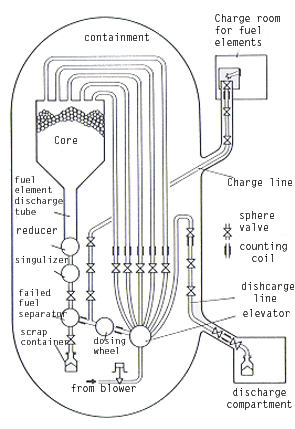For about a decade, I have suggested that our region should keep an eye on Pebble Bed Modular Reactors [PBMRs] as a key potential energy technology. (NB: The proposed scale of the PBMR modules is ~ 100 - 500 MW units, perhaps smaller, which is well-suited to Caribbean utility scales for the larger islands. Where smaller islands have geothermal resources or similar opportunities, these should be pursued.)
Fig. A: A PBMR reactor (Source: MIT, fair use)
I am now suggesting that we monitor potential developments with Liquid Fluoride Thorium Reactors (LFTR, pronounced "lifter").
Such Molten Salt Reactors [MSRs] use Thorium, which is a far more abundant fuel and one that will be basically "burned up" in the process, leaving much less waste, and a waste that is hot for a much shorter time. Indeed, the LFTR apparently can burn up a significant part of existing radioactive wastes.
LFTRs are of similar scale to PBMRs, and are -- a test reactor was built and run at Oak Ridge national Laboratory, USA in 1965 - 69 -- a demonstrably safe [they used to shut it down on weekends, no problem], small footprint technology:
Fig. B: A LFTR (Source: Wikipedia, public domain. A short video clip describing the LFTR is here, and a 55 minute lecture is here.)
It is worth the while pausing to watch the 4 minute talk:
The essential idea, from HowStuffWorks, is:
A summary of how this technology works:
1) You start with a fluoride salt. In this reactor it will be heated so much that it melts.The fission products are relatively benign and short-lived compared to those of a traditional reactor.
2) You dissolve thorium fluoride in the liquid salt.
3) Thorium-232 absorbs neutrons and turns into Uranium-233. [That is, the pump has to be primed, so to speak.]
4) The Uranium-233 fissions and produces heat plus more neutrons [which keep the process going].
Advantages include:
1) There is no pressure – unlike traditional nuclear reactors which contain high pressue steam. So the reactor cannot explode.
2) The fuel does not need to be shaped into pellets
3) The reactor can add fuel and remove waste at any time
4) There are no weapon-grade materials involved
5) Thorium is abundant and most of it is used up in the reaction
Subtler advantages include that LFTRs are potentially quite small, and so can cost perhaps US$ 2,000 power 1 kW capacity, which is quite competitive with any other significant technology out there. Another is that since a LFTR uses Th dissolved in molten salt, the reactor loop is kept going by keeping the salt molten. A "plug" will allow the salt to simply deposit and cool down in a sump, being automatically and passively safe, indeed that is how the ORNL test reactor was routinely shut down for the weekend in the 1960's. The reactor is also naturally load following, i.e. if demand surges, power output automatically surges to compensate through an inherent negative feedback triggered by the temperature of the core.
Thorium is also fairly common as a mineral resource, being comparably abundant to say Lead, and is a lot more common than the major Uranium isotope used in making reactors, U235. Thorium ores also tend to have a lot of the rare earth metals used in high strength magnets, and in fact, that is what keeps many potential sources of these metals used in high efficiency motors -- such as would be needed for a viable electric vehicle -- expensive (as there is no real market for Thorium).
There are of course the usual debates over any nuclear technology, but Th is arguably unlikely as a route to nuclear proliferation, and in fact Th reactors could be used to burn up existing wastes.
Different estimates exist on time to deploy, some suggesting as few as two years, others, up to twenty. The upper end is probably driven by the balance of power in policy-influencing institutions, not least, because LFTRs have already been built and run.
So, energy experts and others interested in energy options in our region should keep an eye on this technology. END
____________
U/D, Mar 4: I am retrospectively retitling this as the start for a new theme, Capacity Focus, joining three others: Matt 24 Watch, 1 Chron 12:32 Report, and Blog Visits. This theme will look at specific points that can serve as key elements of capacity building for development and leadership for our region.
____________
U/D, Mar 4: I am retrospectively retitling this as the start for a new theme, Capacity Focus, joining three others: Matt 24 Watch, 1 Chron 12:32 Report, and Blog Visits. This theme will look at specific points that can serve as key elements of capacity building for development and leadership for our region.


No comments:
Post a Comment